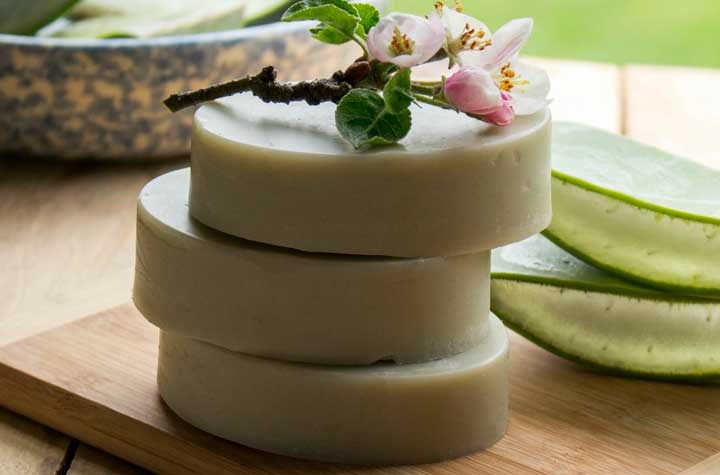
2 Simple Ways To Make Aloe Vera Soap At Home
Have you ever experienced the rejuvenating and healing effects of Aloe Vera soaps? Almost every part of this awesome plant comes packed with benefits. And perhaps the most skin-fantastic part of the Aloe Vera plant is its pulp, extracted from its fleshy leaves. It cures almost anything- skin burns to wounds, yeast, acne and even psoriasis. It is also one of the best natural moisturizers around.
Aloe Vera gel penetrates the 3 layers of skin easily, cleaning out bacteria and oil that block the skin pores and cause breakouts and acne. The enzymes in Aloe pulp also stimulate the reproduction of new skin cells which go on to replace the older skin cells, delaying the appearance of fine lines and wrinkles.
Because of its wide range of beauty benefits, Aloe Vera occupies a prime place as an ingredient of skin creams and soaps.
Go for Aloe Vera soap for keeping the pesky acne, wrinkles and pigmentation away from skin and to keep it softer and younger for long. But the soaps that we buy from shops come packed with chemicals that age our skin and strip it of the natural moisturizers.
The way to get around this is to make a soap using Aloe Vera, right inside your home. Wondering how that can be done? Read on to know!
How To Make Aloe Vera Soap?
Making Aloe Vera soap primarily involves two main ingredients: Oil and lye (Sodium Hydroxide). All you got to do is allow these two to go through a simple but controlled reaction called saponification producing a third product that we call soap.
Before learning to make soap using Aloe Vera, you have to learn how to make natural soap at home. Here is how this is done:
Method For Making Natural Soap:
Follow these simple steps to make natural soap at home:
- Wear gloves to save yourself from Sodium Hydroxide burns. Then take some water into a jar and measure it.
- Use a spoon to measure lye. Pour in 1/4 cup lye into the water and stir as you go. Save yourselves from fumes.
- Allow the water to sit for some time.
- In a jar, add the 3 oils (coconut, olive, almond and sunflower oils) together. They should make a pint.
- Heat the oils in a microwave oven at about 1200 for about a minute. You can also place the jar in a pan of water to heat.
- Wait for the oil mixture to cool down. The oils should cool down to around 950-1050. The temperature is critical. The soap will not come together well if the temperature is lower or higher than this range.
- Slowly add the lye to the oils. Now make sure to stir by hand for a full 5 minutes. This will get the lye in contact with the oils. You will see that the soap mixture will lighten in colour and also thicken. This is called a 'trace'.
- If you want, you can add essential oils, natural colours and essences to the trace and stir thoroughly.
- Get your moulds out and pour the soap mixture in them.
- Cover the moulds with plastic wrap and wrap in a towel to trap the heat inside.
- This will start the saponification process, which we know produces soap.
- Check your soap mixture after 24 hours. If still warm or soft, allow it to sit for another 12-24 hours. Wait till it is cold and firm. Then take out from the mould and wrap the soap in paper.
- Cut the soap into bars.
- Leave the soap to cure for 4 weeks or so.
- Make sure that you turn it over once a week to expose all its sides to air.
- Wrap the soap in wax paper or keep it in an airtight container to avoid dust and dirt. Here is your handmade soap, ready for use.
2 Methods To Make Aloe Vera Soap:
1. Making Natural Soap Using Aloe Vera:
You can add Aloe Vera as pulp to make your own natural soap with all the beauty benefits of Aloe Vera.
But, how do you do this? Just follow these steps:
- Remove Aloe Vera pulp from the leaves of the plant.
- Blend the pulp until it is liquefied and becomes a juice.
- Now, add Aloe juice to the water before adding the lye to it and start stirring (step 1 of a.)
- The other way to add Aloe juice is to wait till you have a thin trace and then add it to the soap base (after step 7 of a.)
- We suggest that you add the Aloe juice to the trace rather than adding it directly to the lye as the acid will kind of 'kill' the good stuff in Aloe juice.
- Carry on all steps for making natural soap as detailed above.
2. Quick Aloe Vera Soap Recipe:
If you have less time and don′t want to stress yourself too much, just buy Aloe Vera gel from the market, melt natural soap in a microwave oven and add the two together. Then pour the liquid into molds and you have your own soaps in about 2 days.
Benefits Of Aloe Vera Soap:
The soap has most, if not all, benefits of Aloe Vera.
Aloe Vera Contains:
- Important minerals like zinc.
- Potent anti-oxidants like Vitamins A, C and E that help in skin healing and rejuvenation.
- Anti-histamines which cure skin burns and allergies.
- Anti-microbial and anti-viral constituents to ward off skin infections.
The homemade Aloe Vera soap is fresh and retains more of the benefits of the amazing Aloe than the Aloe soaps one buys in shops and supermarkets. So it′s always best to prepare your own soap at home!
